Regional Newsletters
May 2021 Statewide Newsletter
High-Speed Rail Part of the Governor’s Vision for Moving the State Forward

On May 14, Governor Newsom shared his $100 billion California Comeback Plan, which lays out the administration’s blueprint to continue the state’s economic recovery. As part of that plan, the Governor proposed a sweeping transportation investment that looks to build on President Biden’s proposed American Jobs Plan and federal legislation to reauthorize and increase funding for surface transportation programs. The high-speed rail program is a major component of that investment, and the Governor’s plan allocates $4.2 billion in remaining Proposition 1A funds – already approved by the California voters to get high-speed rail up and running in the Central Valley and final routes identified from the Bay Area to Southern California.
The majority of these funds will be used to complete all 119 miles of construction underway in the Central Valley by December 2023. The high-speed program has already created thousands of good-paying jobs in the Central Valley, an area of the state that has often lagged in terms of jobs and economic opportunities. Since major construction began, more than 5,500 jobs have been created. The majority of these jobs are being filled by workers from the Central Valley, which means they can work and live in the same area and spend their wages on businesses in the community further spurring job growth and new opportunities. Funds from this allocation will also be used for testing trains in the Central Valley by mid-decade, and for service between Merced and Bakersfield by the end of the decade.
Beyond the Valley, these funds will also be used to continue the work that has been ongoing to environmentally clear and make the high-speed rail routes from the San Francisco Bay Area to the Los Angeles Basin shovel-ready by the end of 2023.
A Conversation with the Northern California Director of Projects
Boris Lipkin, Northern California Regional Director for the California High-Speed Rail Authority, chats with our Northern California Director of Projects Gary Kennerley about environmental clearance work in Northern California.
View their conversation at https://youtu.be/VxoFQVyD3tQ.
LaDonna’s Corner: Southern California Environmental Milestones
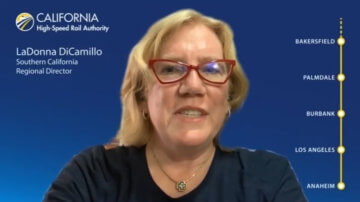 In LaDonna’s Corner, Southern California Regional Director LaDonna DiCamillo highlights upcoming milestones in the Southern California Region with two project sections – the Bakersfield to Palmdale project section and the Burbank to Los Angeles project section.
In LaDonna’s Corner, Southern California Regional Director LaDonna DiCamillo highlights upcoming milestones in the Southern California Region with two project sections – the Bakersfield to Palmdale project section and the Burbank to Los Angeles project section.
The first environmental milestone the Southern California team is working on is the release of the Final Environmental Impact Report and Environmental Impact Statement, or “EIR/EIS,” for the Bakersfield to Palmdale project section. This environmental study, which will be the first clearance into Los Angeles County, will be out in the next few weeks and study results are anticipated to be presented to the Authority’s Board of Directors for approval in summer 2021.
The second milestone the Southern California team is working on is the release later this year of the Burbank to Los Angeles project section Final EIR/EIS, to be presented to the Board of Directors for their approval later this year.
Visit the Authority’s website at www.hsr.ca.gov for information on the four project sections in the Southern California region, and to sign up for email updates on any section.
View her video at https://youtu.be/sIDjY1oOkaA.
Progress Happening Around the State

On May 19, the Authority released its latest Construction Update showcasing the progress being made on high-speed rail in the Central Valley. The update features the latest projects underway and uses drone footage of many of the structures under construction or near completion. Later that week, Chief Executive Officer Brian Kelly provided the Authority’s Board of Directors with a with a comprehensive overview of construction progress in the Central Valley and next steps.
In addition to this construction progress, CEO Kelly also highlighted several agreements we reached in the Central Valley that will help pave the way to bring high-speed rail into Merced and Bakersfield. He also previewed a future Request for Proposals for advance preliminary design for the four stations in the Central Valley that we anticipate coming back to the Board on later this year.
He also provided a brief look-ahead for the next 12-15 months, which included environmental clearances of the Bakersfield to Palmdale and Burbank to Los Angeles project sections, the first two segments into Los Angeles County. Other major milestones include awarding the Authority’s Track and Systems contract and the commencement of work, complete negotiations with Federal Railroad Administration on grant schedule and to retain our previously allocated federal funding, awarding contracts to advance design work on Merced and Bakersfield extensions, and procurement for trainsets.
To read more about these items, please view the May CEO Report.
2021 Climate Adaptation Plan
 California High-Speed Rail is an important investment for the State of California for many reasons. It generates job opportunities and economic growth, improves transportation options and mobility around the state, and is critical in helping California reach its ambitious greenhouse gas reduction targets. Thus, it is important for California High-Speed Rail to be built in a way that is resilient and prepared for climate change throughout the life of the system.
California High-Speed Rail is an important investment for the State of California for many reasons. It generates job opportunities and economic growth, improves transportation options and mobility around the state, and is critical in helping California reach its ambitious greenhouse gas reduction targets. Thus, it is important for California High-Speed Rail to be built in a way that is resilient and prepared for climate change throughout the life of the system.
Recognizing the need to understand how changing climate could affect the system and how the Authority can prepare for the future, the Sustainability Team of the Authority developed the program’s first Climate Adaptation Plan. The plan summarizes work to date by the Authority to assess changing climate hazards like temperature rise and precipitation change and ways in which the Authority is preparing for those changes through design, operations and maintenance, and program-level strategies. The Climate Adaptation Plan also summarizes key next steps for the agency, which include implementing a Climate Policy and integrating climate risks into the Authority’s risk management process. The plan is expected to be a useful resource for Authority staff who need to understand how climate change may affect the system and decisions they make day-to-day.
The Authority recognizes that as climate will change, so will the best available information needed to assess climate change and adapt. The 2021 Climate Adaptation Plan is expected to be the first of its kind and will be updated as new climate data and information become available, and as the Authority makes progress on the next steps identified to prepare for an uncertain future.
A two-page overview of the Climate Adaptation Plan is available here.
Celebrating Sustainability at High-Speed Rail
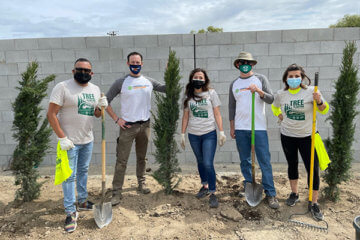 From electric cars and planting trees to Reddit Ask me Anything chatter with Director of Planning and Sustainability Meg Cederoth—we celebrated Earth Day all month!
From electric cars and planting trees to Reddit Ask me Anything chatter with Director of Planning and Sustainability Meg Cederoth—we celebrated Earth Day all month!
To kick off our festivities, we rolled out our latest video (también en español) discussing how the Authority is contributing to cleaner air at our construction sites. With the Authority requiring all construction vehicles be Tier 4, it’s helping reduce nitrogen oxide and particulate matter by more than 50 percent or greater in some instances. Also, Zero Emission Vehicles (ZEVs) make up 25 percent of our fleet of vehicles used to travel around construction sites. We hope to soon have that number up to 100 percent of our fleet.
As part of our ongoing efforts to go green and offset construction emissions, we partnered with Tree Fresno to plant trees in the Central Valley. Community members, California Volunteers staff and our own Fresno team took time out of their Saturday on April 24 to plant nearly 135 trees as part of a full project of about 360 trees at Green Valley Recycling in Fresno. Over the last four years, Tree Fresno has planted nearly 3,000 trees as part of the Authority’s Urban Forestry Program. See a video of the most recent tree planting in Fresno.
To close off the month, staff worked together to support a Reddit Ask Me Anything (AMA) event with Director of Planning and Sustainability Meg Cederoth. The 7th most popular website in the U.S., Reddit is a social news platform that hosts AMAs that allow users to engage with experts. The event received more than 180 comments and questions about sustainability, stations, land use and other questions about the high-speed rail project.
Youth Excitement for California High-Speed Rail Reaches National and International Stages
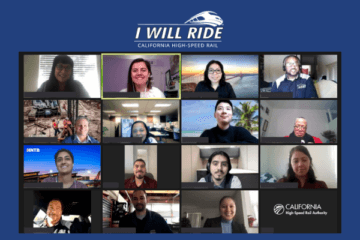 The California High-Speed Rail Authority (Authority) is winding down the Spring semester after a jam-packed season of student outreach. With the relaunch of the I Will Ride program in 2020, the Authority laid the foundation to reach students in the virtual landscape available in 2021. More than just connecting with students through presentations, the Authority continued to build strategic partnerships with schools and students to expand learning and work opportunities on the project.
The California High-Speed Rail Authority (Authority) is winding down the Spring semester after a jam-packed season of student outreach. With the relaunch of the I Will Ride program in 2020, the Authority laid the foundation to reach students in the virtual landscape available in 2021. More than just connecting with students through presentations, the Authority continued to build strategic partnerships with schools and students to expand learning and work opportunities on the project.
Student outreach strategies for a new semester are based on one of the principle pillars of the I Will Ride program; through strategic collaboration with colleges and universities, I Will Ride will engage a diverse student demographic historically underrepresented in transit development. With the collaborative work of staff in all regions, the Authority hosted 13 student presentations, one high-speed rail webinar and continued meaningful partnerships with programs like the Transportation Career Academy Program (TCAP) at LA Metro and the Mineta Transportation Institute at San Jose State. The Authority reached hundreds of students statewide in a variety of grade levels and planted a seed of excitement for a new mode of transportation that they envision in the future of California transit.
The excitement and advocacy of this younger generation was similarly reflected with national coverage on MSNBC. In the segment “Cali Rails Are Gen-Z’s Big Dream,” Senior National Correspondent Chris Jansing went out to Madera, California to tour construction and talk with Authority CEO Brian Kelly about the project. “Gen Z is very tuned in to long term sustainability from our activities today and understanding our impacts on the climate in general” noted Kelly. “Ultimately, this project will be a lot about this [Gen Z] generation, as they will enjoy it as they move through their lives.” Jansing closed the segment noting President Biden’s desire for a railroad revolution and the popular map that has circulated Twitter that visions a national high-speed rail network in the U.S.
The youth vision for high-speed rail also included the opportunity to build new technology and advance a new workforce in high-speed rail development. The Authority was part of the WTS International conference, Our Future in Transportation, with the session Mentoring and Developing the Next Generation of High-Speed Rail Workforce in the Silver Tsunami sessions. During the session, members of the Authority and a Fresno City College professor, part of the I Will Ride program, led a panel discussion and Q&A session about the importance of mentoring and reaching the student audience. In the panel, they discussed the I Will Ride program and its goals.
As discussed on the panel, there is a lot of work left to do within student outreach and expanding the I Will Ride program. It is important to continue student outreach in classrooms and student-led organizations to expose students to the project statewide. Also, just as important is the continual building of relationships with institutions and businesses to create real and tangible opportunities to work on California high-speed rail or similar transit projects. With a vision of a national high-speed rail network, there is an exciting opportunity with the California High-Speed Rail as the Authority leads the nation to create the first high-speed rail in the United States. The Authority is showing students how it’s done – so they can finish the job.
Get Vaccinated
 The Vaccinate ALL 58 campaign launched a weekly newsletter in March to share the latest news, key messages, tools and resources around the vaccine and to help keep Californians up to date on what’s happening at the federal, state and local level. If you would like to sign up for the distribution list or view information from past newsletters, please click here.
The Vaccinate ALL 58 campaign launched a weekly newsletter in March to share the latest news, key messages, tools and resources around the vaccine and to help keep Californians up to date on what’s happening at the federal, state and local level. If you would like to sign up for the distribution list or view information from past newsletters, please click here.
Quarterly Newsletter Archive
- Spring 2023 All Aboard Newsletter
- Winter 2023 Quarterly Newsletter
- Fall 2022 Quarterly Newsletter
- Summer 2022 Quarterly Newsletter
- Spring 2022 Quarterly Newsletter
- Winter 2022 Quarterly Newsletter
- Fall 2021 Quarterly Newsletter
- Summer 2021 Quarterly Newsletter
- Regional Newsletter - May 2021
- Regional Newsletter - February 2021
- Regional Newsletter - November 2020
- Regional Newsletter - August 2020
- Regional Newsletter - June 2020
- Regional Newsletter - February 2020
- Regional Newsletter - November 2019
- Regional Newsletter - August 2019
The California High-Speed Rail Authority makes every effort to ensure the website and its contents meet mandated ADA requirements as per the California State mandated Web Content Accessibility Guidelines 2.0 Level AA standard. If you are looking for a particular document not located on the California High-Speed Rail Authority website, you may make a request for the document under the Public Records Act through the Public Records Act page. If you have any questions about the website or its contents, please contact the Authority at info@hsr.ca.gov.


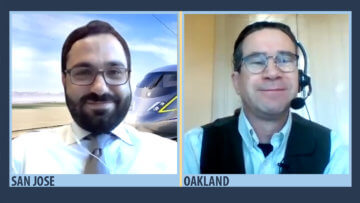
 New Deputy Regional Director
New Deputy Regional Director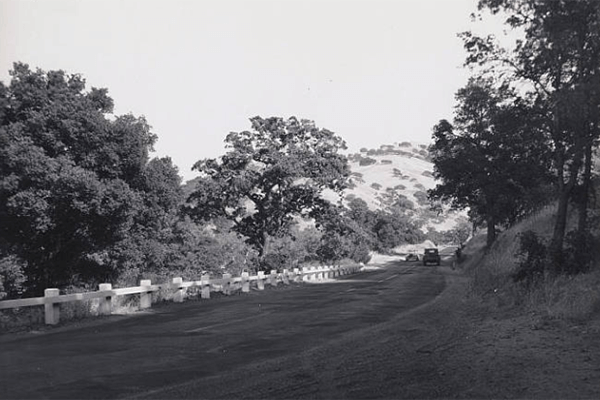
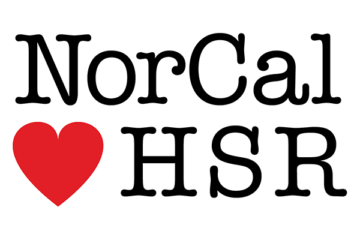
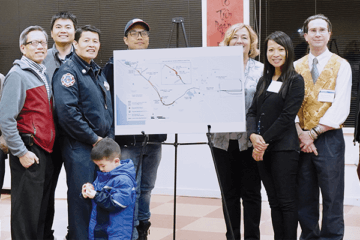 During the summer of 2019, Cici Vu led walks through tent encampments along the railroad tracks in several Bay Area cities. She spoke with the people living there about high-speed rail development— and listened to their concerns. Her goal was to foster an environment of respect and dignity and to ensure underrepresented people had a say in their community.
During the summer of 2019, Cici Vu led walks through tent encampments along the railroad tracks in several Bay Area cities. She spoke with the people living there about high-speed rail development— and listened to their concerns. Her goal was to foster an environment of respect and dignity and to ensure underrepresented people had a say in their community.
 The Southern California Regional team welcomes Beverly Kenworthy to the team as Southern California Deputy Regional Director. She will play a leadership role in the region, working with our partners to advance the high-speed rail program through the next set of significant milestones and beyond.
The Southern California Regional team welcomes Beverly Kenworthy to the team as Southern California Deputy Regional Director. She will play a leadership role in the region, working with our partners to advance the high-speed rail program through the next set of significant milestones and beyond. Carol Singleton joins the Southern California communications team this June as the Media and Outreach Manager. Carol was in the U.S. Army before starting a career as a high school English and Journalism teacher in California’s Central Valley, and she brings a wealth of experience in state government.
Carol Singleton joins the Southern California communications team this June as the Media and Outreach Manager. Carol was in the U.S. Army before starting a career as a high school English and Journalism teacher in California’s Central Valley, and she brings a wealth of experience in state government.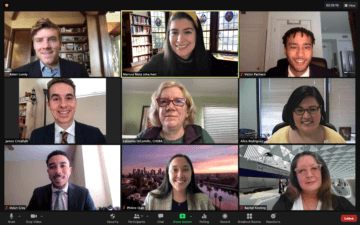

 In live public meetings, an interpreter, providing services for the California High-Speed Rail Authority is hard to miss. They are the person standing near the speaker wearing headsets and talking quietly into a microphone. Diana Orozco, a translator with Lazar Translating & Interpreting, brings her expertise to the Southern California public meetings about high-speed rail. During the last year, she has experienced new interpreting challenges because COVID-19 has pushed public meetings online-related transition to online public meetings.
In live public meetings, an interpreter, providing services for the California High-Speed Rail Authority is hard to miss. They are the person standing near the speaker wearing headsets and talking quietly into a microphone. Diana Orozco, a translator with Lazar Translating & Interpreting, brings her expertise to the Southern California public meetings about high-speed rail. During the last year, she has experienced new interpreting challenges because COVID-19 has pushed public meetings online-related transition to online public meetings.